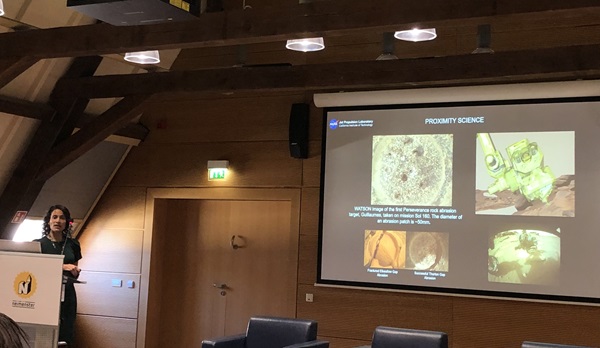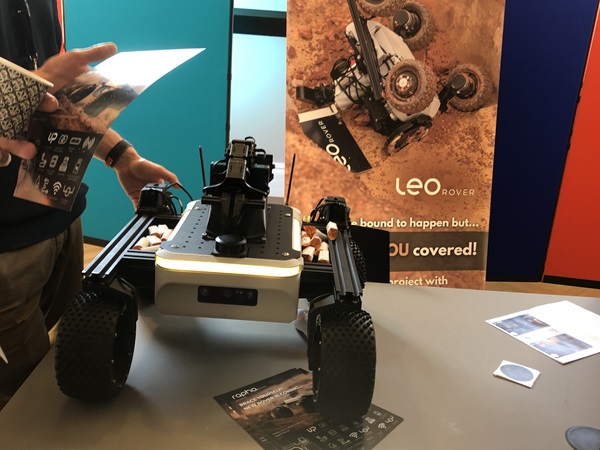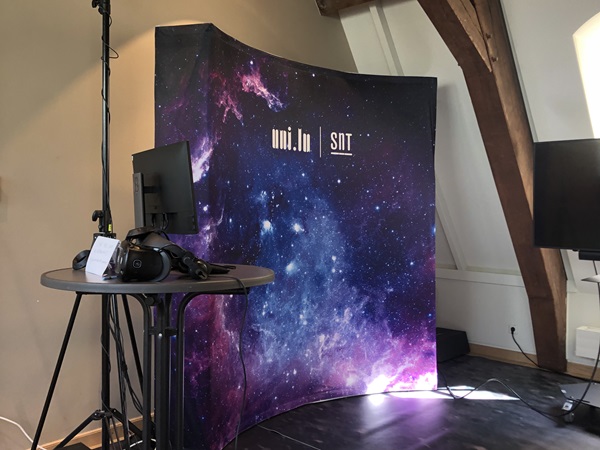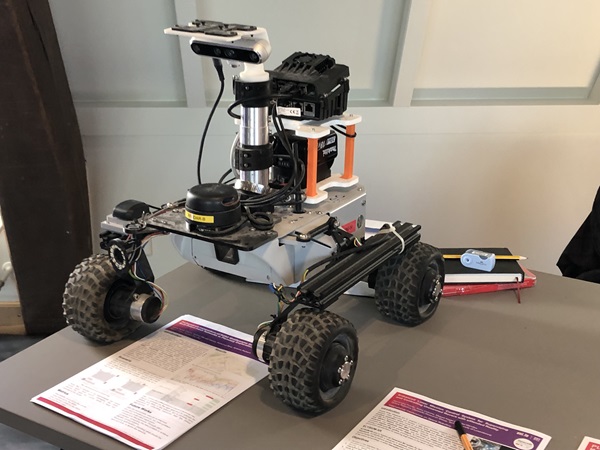 Dr Vandi Verma, space roboticist and chief engineer at NASA's Jet Propulsion Laboratory;
Credit: Otilia Dragan/Chronicle.lu
Dr Vandi Verma, space roboticist and chief engineer at NASA's Jet Propulsion Laboratory;
Credit: Otilia Dragan/Chronicle.lu
The first edition of the International Conference on Space Robotic (iSpaRo) 2024 started on Monday 24 and is set to take place until Thursday 27 June 2024 in Luxembourg and Europe.
iSpaRo includes keynote sessions, contributed paper sessions, workshops and exhibitions where the attendees can see first-hand the latest advancements from industry and academia.
On Tuesday 25 June 2024, the day started at the Abbaye de Neumünster (neimënster) in Luxembourg-Grund with a keynote speech by Dr Vandi Verma, space roboticist and chief engineer at NASA's Jet Propulsion Laboratory. She spoke about the Mars rovers she is best known for driving, Curiosity and Perseverance, and whose software she co-wrote and developed, (including PLEXIL programming technology).
She first discussed the challenges robotics professionals can encounter in space and the solutions implemented to solve the various issues.
During her presentation, Dr Vandi Verma showcased real images captured by the Perseverance rover, highlighting its capability to navigate diverse terrains. As the rover ventures further across Mars, it often loses its exact location due to the lack of GPS on the planet. This growing uncertainty in its position, known as odometry uncertainty, is a challenge when the rover drives autonomously. Currently, human operators on Earth manually localise the rover. To enhance onboard localisation, the rover uses a Qualcomm Snapdragon 801 coprocessor, which is a high-speed computer running on a relatively slow machine. The team employs correlation techniques to reduce localisation uncertainty. By running the Snapdragon processor, the system can achieve accurate localisation in less than two minutes, allowing for more precise navigation. This ongoing upgrade of Martian maps is expected to enable Perseverance to drive much further.
She explained that operating the Curiosity rover is a complex, collaborative effort involving a large team of scientists from various disciplines. Each set of commands issued to the rover is the result of extensive planning and coordination. The process begins with evaluating 3D images captured during previous missions to assess the terrain and identify areas of interest. Scientists then develop a strategic plan and route designed to maximise the rover's exploratory potential while ensuring its safety. This includes using Curiosity's 2-metre robotic arm to conduct detailed experiments and collect samples. The team choreographs and simulates the rover's movements, integrating each step into a comprehensive set of instructions. This detailed approach ensures that each mission is executed efficiently and safely.
Dr Vandi Verma also noted that autonomous science on the Mars rovers has advanced significantly, allowing for the capture and analysis of data directly on the planet. The rover can now, for example, select one or two targets from about 265 options based on pre-determined criteria. It then uses a laser to turn the selected rock into plasma, which emits light that helps to obtain high-resolution images for scientists to study. This process is complemented by proximity science, where a robotic arm or other instruments come into direct contact with the surface being studied for detailed examination.
One challenge with proximity science is dealing with Mars' dust, she explained. Unlike Curiosity, which used a brush to clear dust, the current rover employs a dust removal tool that puffs away the dust, as brushes were found to be less ideal and prone to breaking. However, breaking rocks to place instruments poses a risk for the rovers, making it important to find safer methods for conducting these analyses.
Abraded proximity science involves a precise approach using tools such as abrasion instruments and PIXL (Planetary Instrument for X-ray Lithochemistry), SHERLOC (Scanning Habitable Environments with Raman & Luminescence for Organics & Chemicals), and the WATSON camera. The process typically takes about two sols (Martian days). On the first sol, the rover's robotic arm carefully abrades a rock surface and deploys these instruments to analyse the target. On the second sol, the arm retracts and the rover continues its drive.
Because of the time-intensive nature of this detailed analysis, scientists often prefer to keep the rover moving to cover more ground and gather broader geological data. Each sol on Mars presents unique challenges and opportunities, with no two sols being the same.
The data collected from the rover's instruments are crucial for running numerous simulations back on Earth. These simulations, which include potential error scenarios, help scientists plan and optimise the rover’s operations pre-emptively, ensuring its mission continues smoothly and efficiently.
Dr Vandi Verma lastly discussed the 2023 Decadal Survey outlines the future needs of robotics technology to achieve breakthroughs in planetary science. Every ten years, these surveys set the priorities for advancing our exploration capabilities. The key areas identified last year for the next decade included:
- going farther and sampling more: to extend the reach of exploration missions and enhance sampling capabilities, a higher degree of autonomy is required; enabling rovers and other robotic systems to travel further and collect diverse samples without constant human intervention;
- smaller-scale science robots: there is a need for more frequent, smaller-scale missions. An example of this is a demonstration robot weighing just 2.6kg, highlighting the potential for lightweight, efficient exploration tools that can be deployed more regularly;
- accessing more challenging terrain: future missions need robots capable of navigating difficult terrains, requiring improvements in perception and illumination technologies, as poor lighting conditions often hinder exploration; enhanced vision systems, autonomous long-range mobility, and advanced manipulation and sampling techniques are essential. Additionally, aerial platforms like helicopters (e.g., HALO) are being considered for their ability to carry scientific instruments over rugged landscapes.
These advancements aim to enable robots to explore more ambitious and scientifically valuable locations, pushing the boundaries of what’s currently possible in planetary science.
The day continued with a visit to the space labs and various specialised workshops, keynote speeches and a networking cocktail. The full conference programme is available at: https://www.isparo.space/program-1.












